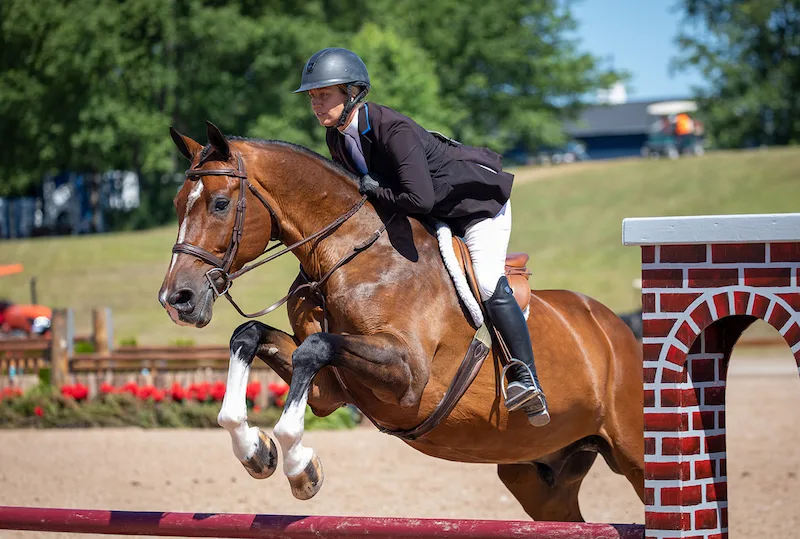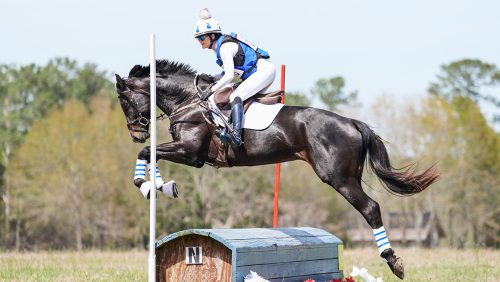We’re only a week away from the Platinum Performance/USHJA Green Hunter Incentive Championship and the Platinum Performance/USHJA International Hunter Derby Championship, two of the biggest events of the year for hunters.
Leading up to events like these, my horses’ preparation is always at the forefront. For any of the horses in our barn—whether they’re hunters, jumpers, equitation mounts or even ponies—I always aim to create a training schedule and routine specific to them. I want it to be a program that keeps them fit and sound, helps them to peak at the right times, allows them to perform their best, and, perhaps most importantly, keeps them happy.

Caitlyn Shiels’ rarely jumps Cassius at home and keeps his training program relaxed. Fine Art Horses Photo
I’ve noticed that if you Google a phrase like “show jumping training schedule” or “show horse training schedule,” the articles don’t mention anything about the horse’s happiness or what the horse might think about the program.
You’ll find lots of suggestions on fitness and flatwork, on not over-jumping at home, on identifying your goals and mapping out your horses’ show calendars, but I think the most important element is often missing—and that’s listening to your horse.
And I don’t just mean noticing that your horse maybe isn’t quite sound and then adjusting accordingly. I mean really knowing your horse and understanding what his or her personality, demeanor and performance are trying to tell you.
As I look toward Kentucky and the two championships in August, I think of two horses in particular: Cassius, a 10-year-old warmblood gelding owned by Durpetti Equestrian LLC, who I’ll compete at derby finals, and CW Fringe Benefits, a 5-year-old Westphalian gelding owned by Corporate Way LLC, who I’ll ride in the green incentive.
In 2017, Cassius and I jumped our first derby finals together (which I blogged about here, here and here), and I was so proud of him. Looking back now, how we prepared for that first derby finals is so different than how we prepare today.
Over the last three years, I have evolved with Cassius as he has grown and learned from the derbies, and with that, his program has evolved as well.
ADVERTISEMENT
I learned that putting him into more difficult situations like complicated grid work makes him nervous, and if I were to really work him hard every day or even several days a week, that sort of boot camp would make him really sour. When he’s at home, he’s not in the frame of mind to be a show horse. In fact, he can be a bit of a curmudgeon at home! So we’ve have established a regime that not only keeps him jumping and performing well but keeps him loving his job.
We rarely jump at home, and when we do, we never jump big. He knows his job and doesn’t need complicated exercises to help him perform better, so I keep it simple. And, to keep him from being a curmudgeon, I really let him be a horse!
His day-to-day workout isn’t as regimented as that of many of our other horses. Instead, while I make sure that he’s engaged and doing what is asked, our rides are more relaxed.
If his owner, Michelle Durpetti, or someone else rides him at home, he’ll contently poke his nose out and look a bit ridiculous, but he’s truly the happiest horse ever.
And when we get to a show, he steps right up to the plate every time. If he didn’t enjoy his job and get to be a horse at home, I don’t think he would do the things that he does for me at horse shows.
On the flip side, other horses thrive in a more regimented, boot camp-esque program.

CW Fringe Benefits is just 5 years old, so his training program focuses on strengthening and fitness. Fine Art Horses Photo
CW Fringe Benefits, better known in the barn as “Porter,” is one of those horses.
From the time he arrived stateside a few months ago, his program has been all about strengthening, fitness and focusing on any weak spots. He’s not as strong on the left lead as he is on the right, so some of the exercises that I’m doing at home involve big crossrails with landing poles that make him really think about his shape.
ADVERTISEMENT
If I were to take one of our jumpers out and do the same grid I do with Porter, it likely wouldn’t work the same way, but it’s perfect for him.
As a 5-year-old, Porter’s mind is phenomenal. He already has the most ridiculously, steady Eddie-type brain that continuously amazes me—and he is thriving in a structure much different than Cassius’.
And that brings me back to my point. If you want to develop the truly best program for your horse, you’re not going to find the perfect training schedule online; you’re going to find it in the barn when you spend time with your horse and get to know what suits it best.
Since launching my own business, I’ve learned a lot more about human personalities, interacting with various personality types, and how people respond differently to the same scenario—and horses are no different.
Like us, they are all uniquely wired with their own set of personality quirks and strengths and weaknesses, and if we want them to do their best for us, we have to take the time to listen to them, to get to know them, and to create a program that allows them to thrive. And then, as we head into these upcoming championship events, we hope for the best!
Born and raised in Sheffield, Massachusetts, Caitlyn Shiels began riding at the age of 8. In 2018, Shiels launched her own True North Stables, based in Illinois and Florida and dedicated to providing individualized training and opportunities that allow horse and rider to excel in the sport.














